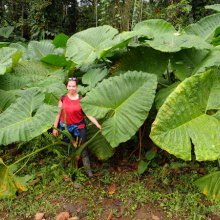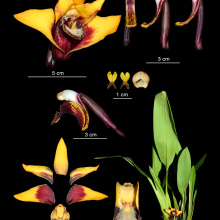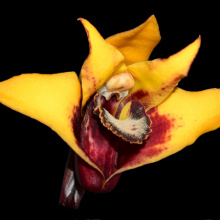Dr Monika Lipińska.
Dr Monika Lipińska together with prof. Dariusz Szlachetko from the Department of Plant Taxonomy and Nature Conservation, Faculty of Biology, UG, have discovered an astonishing new species of a rare orchid for science. This plant, known from a limited area in the Carchi province, is probably a critically endangered species, as its rare populations are exposed to the negative effects of climate change and human activities.
A new orchid species discovered in the misty rainforests of northern Ecuador is called Maxillaria anacatalinaportillae Szlach. & Lipinska and is native to the Carchi province - and what's more, it only appears in that province's territory.
- 'Alex Portilla collected the first specimen back in 2003 and his company marketed it under the (informal) name Maxillaria sanderiana xanthina. Together with prof. Dariusz Szlachetko, Dean of the Faculty of Biology of the University of Gdańsk, we encountered these plants on various occasions (e.g. in private collections or during orchid exhibitions) and noticed certain features of the flower structure that did not match Maxillaria sanderiana,' - says dr Monika Lipińska from the Department of Plant Taxonomy and Nature Conservation of the Faculty of Biology UG. - 'We then decided to conduct phylogenetic studies and detailed morphological analyses with our team, which clearly showed that we were dealing with a previously undescribed species.'
As the UG biologist explains, Maxillaria anacatalinaportillae is a plant distinguished by its showy, intense yellow flowers that has been described by Polish orchidologists in cooperation with an Ecuadorian company that produces and exports orchids.
- 'Most new species are now described from herbarium material collected many years ago. It sometimes happens that such species from herbarium sheets are never found in the wild again. In this case, we are dealing with a discovery based on "live" plants that are still found in nature,' - stresses dr Monika Lipińska. - 'Like many representatives of orchidaceae, our new species is probably threatened with extinction as it occurs in a rather limited area that has been strongly transformed in recent years.'
The research was based on a private, informal collaboration between the biologist and Ecuagenera, a company that leads the world in sales of tropical orchids. - 'At my request, Ecuagenera provided us with the material, while the formal financing of the research was based on funds from the statutory activities of the Department of Plant Taxonomy and Nature Conservation and my grants: one for Young Researchers of the Faculty of Biology and two European grants within the SYNTHESYS programme,' explains dr Monika Lipińska, who has been researching the genus Maxillaria as well as the entire subfamily Maxillariinae since 2015.
Botanists note that Ecuador is one of the countries with the highest biodiversity index. Its flora is estimated to include around 25,000 species of vascular plants (or 10% of the world's species) and as many as 5,000 of these are orchids. They represent about one-third of all endemic vascular plant species of Ecuador (1,710 species) and are found in all habitats at altitudes from 0 to 4,500 metres. Most of the endemic orchids are found in mountain microhabitats at 1500-3000 m altitude, especially in misty forests, and 85% of them are considered endangered.
It is worth recalling that over the past few years, scientists from the University of Gdańsk have worked intensively on the classification and pollination biology of the neotropical subfamily Maxillariinae - one of the largest in the orchid family. They have examined material deposited in most of the world's herbarium collections in Europe and the Americas, and have made more than a dozen field trips to South and Central America in search of these astonishing plants.



